How to Remove A Ring from A Swollen Finger?
Imagine the panic: you glance down at your hand and realize your cherished ring has become a prisoner on your swollen finger. This scenario is far from rare, yet it often catches us off guard, transforming a symbol of beauty or commitment into a source of distress. Swelling in the fingers can occur for a myriad of reasons – from weather fluctuations to health-related changes – and when it does, rings can feel like unyielding metal traps. The struggle to free your finger is not just about preserving your ring or keeping up appearances; it’s a crucial step to prevent potential injury or further swelling. In this comprehensive guide, we delve into the world of stuck rings and swollen fingers, offering expert advice and safe methods to reunite your finger with freedom. Whether it’s a family heirloom, a wedding band, or simply a favorite piece of jewelry, learning the art of safe removal is essential. So, let’s unfurl the mystery and equip you with the knowledge to skillfully and gently liberate your ring – and your finger – from their uncomfortable bind.
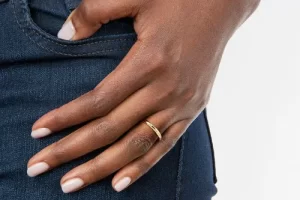
Understanding Why Rings Get Stuck
Causes of Finger Swelling
Finger swelling, a common precursor to stuck rings, can arise from a variety of sources. Weather changes, especially heat, often cause fingers to expand as the body tries to regulate temperature. Injuries, such as sprains or fractures, can lead to localized swelling, making rings feel tighter. Health-related issues are also significant contributors. Conditions like arthritis, edema, or even pregnancy can result in swollen fingers. Another factor to consider is fluid retention, often triggered by medications, dietary habits, or hormonal changes, leading to increased finger size.
Ring Removal Challenges
Once a finger swells, removing a ring becomes more difficult. The swelling creates a tighter fit, leaving little room for the ring to move. A key challenge is reduced lubrication; swollen skin tends to be drier and stickier, making it harder for the ring to slide off. The swollen tissues exert increased pressure against the ring, adding to the difficulty of moving it over the knuckle. Additionally, swelling can alter the finger’s shape, creating new contours and obstacles for the ring to navigate during removal. Understanding these aspects is crucial for safely extracting a ring from a swollen finger.
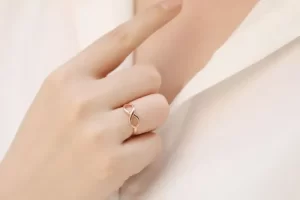
Immediate Steps to Reduce Swelling
Reducing swelling in the finger is a crucial first step in removing a stuck ring. Here are some immediate and effective measures to consider:
A. Elevate the Hand
Elevating the hand above the level of the heart is a simple yet effective way to reduce swelling. This position helps in decreasing blood flow to the swollen area, thereby reducing inflammation. It’s recommended to keep the hand elevated for several minutes, or as long as comfortably possible, to achieve noticeable results.
B. Apply Cold Compresses or Ice
Using cold compresses or ice packs can significantly help in reducing swelling. The cold temperature narrows blood vessels, which decreases blood flow to the affected area and minimizes swelling. Wrap the ice or cold compress in a cloth to avoid direct contact with the skin, and apply it intermittently for periods of about 15-20 minutes.
C. Avoid Exacerbating Activities
Certain activities can worsen swelling and should be avoided. These include strenuous exercises involving the hand, exposing the swollen finger to heat (like hot water), or engaging in activities that strain the hand or fingers. Keeping the swollen finger as immobile and relaxed as possible will aid in reducing the swelling more effectively.
Implementing these steps promptly can lead to a significant reduction in swelling, making the process of removing a stuck ring much safer and easier.

Lubrication Methods for Ring Removal
When dealing with a swollen finger and a stuck ring, lubrication can be a game-changer. Here are some effective lubrication methods:
Using Soap and Water
Soap and water is a classic and readily available solution. The slippery nature of soapy water can greatly reduce friction, making it easier for the ring to slide over the skin. To use this method, immerse the finger in soapy water or apply a generous amount of soap around the ring area. Gently twist and wiggle the ring to work it over the swollen part of the finger.
Applying Oils or Lubricants
Various oils and lubricants, such as petroleum jelly, cooking oil, or even hand lotion, can be used for lubrication. These substances provide a slick surface, easing the ring’s movement. Apply a small amount around and under the ring, ensuring the lubricant reaches the skin beneath the ring. Like with soap and water, gently twist and move the ring to gradually slide it off.
Technique for Applying Lubricants
The key to using lubricants effectively is in the application and the gentle twisting motion. Start by applying the lubricant around the entire circumference of the ring, making sure some of it gets underneath the ring as well. Once lubricated, hold the ring between your thumb and forefinger and gently twist it back and forth, slowly edging it over the knuckle. It’s important to be patient and gentle to avoid causing further injury or discomfort.
Using these lubrication methods can significantly ease the removal process, making it a less stressful and safer experience.
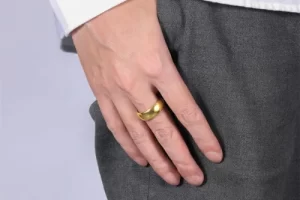
String-Wrap Technique for Removing a Stuck Ring
The string-wrap technique is an effective method for removing a ring from a swollen finger, especially when other methods have failed. Here’s a detailed guide on how to use dental floss or thin string for this purpose:
Step-by-Step Instructions
- Select the Right String:Choose a long piece of dental floss or a thin, strong string. Dental floss is often preferred due to its strength and thinness.
- Slip the String Under the Ring:Carefully slide one end of the string beneath the ring. It’s easier if you tilt the ring slightly upward to create a small gap for the string.
- Wrap the Finger:Starting from the ring upwards towards the fingertip, tightly wrap the string around your finger. Ensure the wraps are close together and cover the area up to your middle knuckle. The idea is to compress the swollen tissue, making the finger slim enough for the ring to pass over.
- Begin Unwinding:Holding the ring, start unwinding the string from the end that was slipped under the ring. As you unwind, the ring should move along with the string, gradually moving over the swollen part of the finger.
- Proceed Slowly and Carefully:Take your time and move gradually. Rushing can cause discomfort or injury.
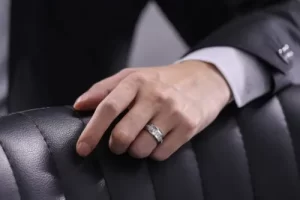
Importance of Wrapping Technique and Gradual Movement
The effectiveness of this technique lies in the wrapping pattern and the careful, gradual movement of the ring. Proper wrapping compresses the swelling, while slow unwinding helps in gently guiding the ring off without causing pain or injury.
Safety Precautions
Avoid Cutting off Circulation: Make sure the string is not wrapped too tightly to prevent cutting off blood circulation.
Monitor for Discomfort: If you feel any pain or numbness, stop immediately. This could be a sign of too much pressure or restricted blood flow.
Seek Assistance if Needed: If you’re unable to remove the ring using this method, or if it causes significant discomfort, seek professional help.
The string-wrap technique, when performed correctly, can be a highly effective way to remove a ring from a swollen finger, minimizing the risk of injury and discomfort.
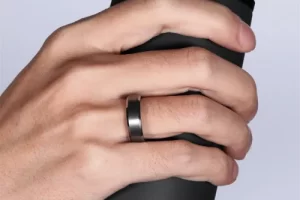
Medical Tape Method for Removing a Stuck Ring
The Medical Tape Method is a less-known but effective technique for removing a ring from a swollen finger. This method uses the compression properties of medical tape to reduce swelling and facilitate ring removal. Here’s how to do it:
Using Medical Tape to Compress Swelling
Choose the Right Tape: Select a roll of medical tape, preferably one that is flexible and gentle on the skin.
Start Wrapping: Begin by wrapping the tape tightly around the swollen finger, starting just above the ring and moving towards the fingertip. The tape should be snug but not too tight, as overly tight wrapping can cut off circulation.
Compress the Swollen Area: As you wrap, ensure that each layer of tape slightly overlaps the previous one. This compression helps to reduce the swelling and makes the finger more slender, easing the removal of the ring.
Leave for a Short Period: After wrapping, leave the tape on for a few minutes. This duration allows the compression to effectively reduce swelling.

Step-by-Step Guide on Ring Removal
Gently Loosen the Ring: After the swelling has reduced, gently rotate the ring to see if it has loosened.
Slowly Slide the Ring: If the ring moves, slowly start sliding it over the compressed area. You may need to rotate and wiggle the ring gently to ease it over the swollen part.
Remove the Tape if Needed: If the ring starts to move along with the tape, carefully cut and remove the tape as you continue to slide the ring off.
Be Patient and Careful: Proceed slowly to avoid causing any discomfort or injury to the swollen finger.
Important Notes:
- Monitor for Discomfort:Constantly check for any signs of pain or numbness. If any discomfort occurs, stop immediately.
- Don’t Force the Ring:If the ring does not move easily, do not force it. Forcing it may cause more harm than good.
- Seek Professional Help if Necessary:If the ring remains stuck despite your efforts, it’s advisable to seek assistance from a healthcare professional or a jeweler.
Using the Medical Tape Method is a practical and gentle way to tackle the challenge of a ring stuck on a swollen finger, offering a safe alternative to more invasive methods.
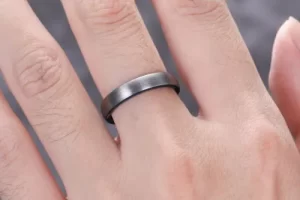
Commercial Ring Removers
In some cases, especially when traditional home methods fail, commercial ring removers can be an effective solution for dislodging a ring from a swollen finger. These tools are designed specifically for this purpose, offering a safer and more controlled approach.
Overview of Ring Removal Tools
Ring Cutter: A common tool used by jewelers and emergency responders, a ring cutter is designed to safely cut through a ring without injuring the finger. It’s especially useful for rings that cannot be removed by other means due to extreme swelling or injury.
Ring Stretcher: This tool is used to gently expand the ring itself, making it easier to slide off. It’s particularly helpful for rings made of softer metals.
Ring Sliding Tool: Some products offer a sliding mechanism that helps to gently push the ring over the swollen part of the finger. These tools often combine lubrication and gentle pressure to ease the ring off.
Safe Usage of Commercial Tools
Read the Instructions: Before using any commercial ring remover, it’s crucial to thoroughly read and understand the product instructions. Each tool works differently, and proper usage is key to avoiding damage to the ring or injury to the finger.
Prepare the Finger: Depending on the tool, you might need to prepare the finger by reducing swelling (using methods like ice or elevation) or applying lubrication.
Gentle Application: When using the tool, apply gentle pressure and avoid forcing the ring off. For ring cutters, ensure the protective shield is properly placed between the ring and the finger to prevent any cuts.
Patience is Key: Work slowly and patiently. Rushing the process can lead to mistakes or injury.
When in Doubt, Seek Professional Help: If you’re unsure about using a commercial ring remover or if the ring is particularly valuable or delicate, it’s best to seek professional assistance from a jeweler or medical professional.
Commercial ring removers can be a viable option for those who need a more advanced solution for removing a stuck ring, offering a balance of effectiveness and safety.

When to Seek Professional Help
While many cases of a stuck ring can be resolved with home methods, there are situations where seeking professional help is necessary. Recognizing these scenarios is important for the safety and well-being of the individual.
Recognizing Risky Situations
Persistent Swelling and Pain: If swelling and pain persist despite trying home remedies, it’s a sign to seek professional assistance. Continuous swelling can lead to further complications.
Signs of Circulation Loss: If the finger becomes discolored, numb, or tingly, it indicates a loss of circulation, which requires immediate medical attention.
Injury or Trauma: If the finger is injured or if there was trauma leading to the swelling, professional evaluation is essential to rule out fractures or serious injuries.
Home Methods Failure: When all home methods have been exhausted without success, it’s time to consult a professional.
Consulting a Healthcare Provider or Jeweler
Healthcare Providers: In cases of severe swelling, pain, or injury, a visit to a healthcare provider is crucial. They can assess the situation and provide medical treatment if necessary.
Jewelers: For less severe cases or when the ring itself is of concern (e.g., valuable or delicate rings), consulting a jeweler is advisable. Jewelers have the tools and expertise to remove rings without damaging them.

Professional Procedures
Ring Cutter: Professionals often use a ring cutter, a tool designed to safely cut through the ring without harming the finger. This is a common procedure in emergency rooms or jewelry shops.
Advanced Swelling Reduction: Healthcare providers might use more advanced methods to reduce swelling, such as medication or specialized treatments, before attempting ring removal.
Customized Solutions: Depending on the ring’s material and the situation, professionals may employ specific techniques tailored to the ring type and the degree of swelling.
Seeking professional help when necessary is crucial. It ensures not only the safe removal of the ring but also the health and safety of the finger involved. In cases of doubt or severe swelling, professional assistance should be sought without delay.
Preventive Measures for Future
To avoid the discomfort and potential risks associated with a ring getting stuck on a swollen finger, there are several preventive measures one can take. These practices not only ensure comfort but also help in maintaining the health of your fingers and the integrity of your rings.
Choosing the Right Ring Size
Proper Sizing: Ensure that your ring is correctly sized. A ring should fit comfortably; snug enough not to fall off, yet loose enough to slide over the knuckle with minimal resistance.
Consider Daily Fluctuations: Finger size can change slightly throughout the day and in different temperatures. It’s best to size your ring when your fingers are at their average size, typically in the middle of the day.
Account for Seasonal Changes: Remember that fingers can swell in hotter temperatures and shrink in colder ones. Consider having rings that are slightly looser for summer use if you live in a climate with significant temperature variations.

Monitoring Conditions That Cause Swelling
Be Aware of Health Factors: Conditions like arthritis, diabetes, or pregnancy can cause fluctuations in finger size. Regularly monitor these conditions and understand their impact on your finger size.
Watch Your Diet: High salt intake and certain foods can cause fluid retention, leading to finger swelling. Maintaining a balanced diet helps in managing this issue.
Stay Hydrated: Dehydration can lead to swelling, so ensure you’re drinking enough water throughout the day.
Regular Checks for Ring Fit
Routine Checks: Regularly check the fit of your rings. If a ring consistently feels tight or leaves an indent, it’s time to consider resizing.
Professional Consultation: If unsure about a ring’s fit, consult with a jeweler. They can provide advice on whether a ring needs resizing and can adjust it accordingly.
Alternative Rings: In case of temporary swelling (like during pregnancy), consider wearing alternative, looser rings or adjustable rings to avoid discomfort.
By taking these preventive measures, you can significantly reduce the risk of having a ring get stuck on your finger in the future. Regular attention to ring fit and being mindful of factors that influence finger size are key to ensuring comfort and avoiding emergencies.
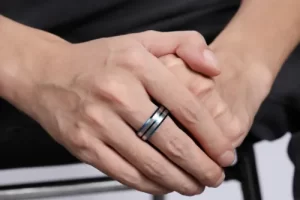
Conclusion
In conclusion, understanding and applying safe techniques for removing a ring from a swollen finger is more than just a convenience; it’s a crucial aspect of personal care. This guide has highlighted various methods, from simple lubrication techniques to professional tools, emphasizing the importance of choosing the right approach for your situation. Remember, being cautious and patient during the removal process is key to preventing injury. If you encounter persistent difficulties or discomfort, don’t hesitate to seek professional help. Lastly, regular checks on your ring’s fit and being mindful of your finger’s health can go a long way in preventing such situations in the future. By staying informed and prepared, you can ensure the safety and well-being of both your rings and fingers.

